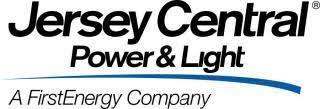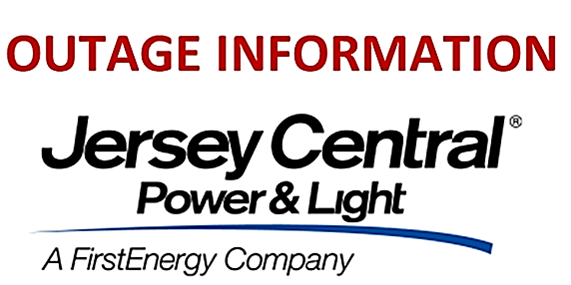JCP&L Emergency Management Guide

What Do I Do When…
- I need to report a power outage.There are several ways to report an outage, including:
- Report an outage online using JCP&L’s online outage reporting tool at https://www.firstenergycorp.com/outages_help/Report_Power_Outages.html.
- Call 888-LIGHTSS (888-544-4877)
- Report your outage via text message; get started by texting REG to 544487. (Message and data rates may apply.) See page 8 for additional information on our SMS communication options.
- View/report power outages on our 24/7 Power Center maps at http://outages.firstenergycorp.com/nj.html. (Note: power outages may be reported through a link on the Power Center map by simply putting in a resident’s phone number associated with their JCP&L account.)
- Customers with a communications disability can report an outage by using the appropriate TTY/TDD relay service, or by using the online form or text message service listed above.
- When reporting an outage, please be ready with the following information:
-
Street address of the outage location
-
Whether or not, to the best of your knowledge, neighbors are affected by the outage
-
Phone number where you can be reached
-
- I have an emergency:
- Call 911, then report to JCP&L.
- If there’s a downed power line, stay at least 30 feet away.
- Emergency responders/dispatchers have a special hotline number for reporting emergencies to JCP&L and a form that can be utilized for reporting non-life and limb emergencies.
- What can I do to prepare for storms or emergency events:
- Communication is key during storms and emergencies.
- You should review your personal emergency preparedness plans.
- Well and septic customers should store a several-day supply of water.
- Be aware about the possibility of falling trees or branches, which present a significant safety issue and are the leading cause of power outages in JCP&L territory.
- Downed Wires & Electrical Emergencies
- You can’t tell by looking if a downed wire is “live” or “hot,” or not. Always assume a downed wire is carrying electricity, which can severely injure or kill you.
- Downed Wires
- Stay at least 30 feet from any downed power line, and don’t go near the pole or anything touching the line.
- Call 9-1-1 immediately, then follow with a report to JCP&L. Provide as much information as possible about the exact location of the downed wire. (Note: Only call 9-1-1 if you actually see a downed wire. Do not assume that because your power is out, there must be a wire down.)
- Warn others to stay at least 30 feet away from the downed line and keep pets away as well.
- If a downed line is near water – even a small puddle – keep well away.
- Don’t drive or walk under or over downed power lines.
- If a wire falls on a vehicle, passengers should stay inside the vehicle until help arrives and provides further instruction.
- Downed power lines that come in contact with a vehicle create a dangerous situation. Do not touch the vehicle. Call 9-1-1 immediately to report it.
- Additionally, be careful not to stand under damaged tree limbs or power lines.
- Tree limbs can be weakened in a storm, but not fall until several hours or days later
-
The same holds true for power lines or poles.
-
Electrical Emergencies
- Report electrical emergencies by contacting 911 immediately
- It's important to provide the exact location when reporting an electric emergency.
- Please provide the following information:
-
The nature of the emergency and whether personal injury or danger is involved
-
The town, street name and house number
-
The nearest cross street and direction (north, east, south or west) from the location
-
The pole number, if you can safely view it
-
The phone number or the nearest phone number at the location if available.
-
If the emergency is on private property, please give the location (front, side or rear).
-
-
Critical Care & Well Water Lists
-
If any member of a household depends on electrically operated life-support equipment, please let us know by calling 800-662-3115 to be added to the Critical Care List.
-
JCP&L will provide a form that must be completed and signed by a physician.
-
In case of power outages, it’s important that life-support customers have a contingency plan, such as a battery backup.
-
If a household or business depends on an electrically operated private well for water, they can be added to our Well Water Customer List by calling 800-662-3115. JCP&L notifies registered Well Water Customers when a power outage is expected to interrupt their electric service for more than 24 hours, and includes locations where ice and water are available.
There is no charge for either service. Both of these lists are provided to county and municipal Offices of Emergency Management.
Water & Ice Program
When widespread outages extend beyond 24 hours, JCP&L will activate its retail water and ice program to assist customers. Customers experiencing an outage extending beyond 24 hours will be able to receive free ice and water from select local supermarkets.
A list of participating locations will be posted when the Ice & Water Program is activated at www.firstenergycorp.com/outages_help/storm_info/water-ice.html.
Email/Text Message Alerts
On their online accounts, customers can also sign up for automated email or text message alerts on topics including:
- Restoration updates when they have reported an outage
- Notifications of scheduled power outages (but not forced outages during storms or emergencies)
- Severe weather alerts in advance of storms
- Billing reminders, including alerts when a new bill is available, a payment is due, a payment has been posted, or no payment has been received, or reminders to submit a meter reading
- Social Media
During storms and emergency restoration activities, JCP&L provides updates on our social media, including our Facebook (www.facebook.com/JCPandL) and Twitter (www.twitter.com/JCP_L) pages.
Outside of storm and emergency situations, these pages are regularly updated with news, energy efficiency and electrical safety tips, and more.
Understanding JCP&L’s Storm Restoration Process
After a storm, JCP&L crews follow a formal process to restore power to all customers as quickly and safely as possible. Storms may damage a variety of electrical facilities, affecting our customers in different ways. Power may be out for a large number of residential customers, as well as hospitals, police and fire departments, water pumping stations, schools and other important public facilities.
Reporting an Outage – Outage Management System
It is important that our customers report an outage, and not rely on their neighbors to do so. When a customer contacts us to report a power outage, the data enters into our Outage Management System, or OMS. This system automatically evaluates the pattern of reported outages and determines the likely location of the trouble. A regional dispatcher then sends a crew to the probable trouble location to determine the extent of the problem and repair it as quickly and safely as possible. The OMS works best when it receives plenty of information to analyze. Even if a neighbor has already reported power being out, you should report your outage, too. The more reports we receive, the more accurately we can determine the extent of the outage and its cause.
Damage Assessment Process
When major storm events occur, FirstEnergy uses location and prediction information from the OMS, in combination with our Geographic Information System, to identify and prioritize storm affected locations. In addition to lineworkers already working to restore outages, we engage personnel to analyze this information and document damage to the electrical system.
This damage information is communicated back to the storm headquarters either by field personnel entering the information into mobile devices, calling in to dispatching personnel or documenting the information on maps for use by the repair crews later in the restoration event. This damage assessment data is important so that we may effectively manage and deploy resources and provide situational reports to government agencies, community leaders, and media.
Prioritizing Restoration Activities
When an outage is widespread, restoring power to all customers at the same time may not be possible, so our crews follow established protocols to help ensure public safety while restoring power as fast as safely possible.
1. Crews isolate and address any public safety emergencies. This may involve crews removing tree hazards or isolating downed wires, then moving on to the next emergency.
2. Repair high-voltage lines and essential functions, such as substations, that are necessary to provide power downstream.
3. Restore critical facilities. Critical facilities include hospitals, other critical medical facilities, police & fire departments and 9-1-1 facilities. JCP&L will work with emergency management officials to prioritize additional facilities, such as senior communities, hospice and for-profit elder care facilities, well and septic concerns, and others.
4. Repair main feeder/distribution lines.
5. Restore areas/outages affecting the largest number of customers.
6. Restore outages affecting individual homes.
Note: When outages occur, we are only responsible for restoring electric service to our customers. If other utility services such as telephone or cable TV are also affected, please contact those companies to have services restored.
Outage Preparedness Tips
Power outages can occur at any time, so it is important to prepare for them before they happen.
Everyday Preparation Tips
- Keep a flashlight, portable radio, and extra batteries handy.
- Know where your electric service panel is located. They are commonly found in the basement, in an attached garage, or other interior locations near the exterior electric meter.
- If you have a water well and pump, keep an emergency supply of bottled water on hand.
- If you use an electric range for cooking, keep an emergency supply of convenience
- foods that do not require cooking.
- If you have a backup generator, be sure you know how to use it safely.
- Keep a plain, hard-wired telephone handy; you may need it to report your electricity is out. Many cordless or feature-laden telephones require a plug-in power source to operate and may not work if a power outage occurs. A cell phone will work as long as its battery is charged (you may want to keep an extra portable power bank) and the nearest cell tower has power or battery backup power. Wait until a storm has passed to report an outage on a hard-wired telephone, as telephone lines can conduct electricity, too.
Thunderstorm Preparation Tips
- Check local weather forecasts.
- Watch for warning signs of an approaching storm.
- Plan ahead - know where you will take shelter in case of a storm.
- Stay indoors. If a suitable building is not available, get inside a vehicle with a steel roof. Do not take shelter in small sheds, under isolated trees, or in convertible automobiles.
- Stay away from tall structures such as towers, fences, telephone poles, or power lines and avoid contact with water, appliances, metal objects, or other conductors of electricity.
- Boaters and swimmers should immediately go ashore and take shelter, well away from the water.
- In the woods, take shelter under shorter trees. Make yourself the smallest target possible. Squat low to the ground on the balls of your feet with your head between your knees. Do not lie flat.
- At home, do not take a shower or bath. Current from a lightning strike can travel through water pipes.
- Do not talk on a hard-wired telephone during the storm. Telephone lines can conduct electricity, too.
- Unplug air conditioners and other major appliances to protect them from lightning strikes.
- Tune to a local radio or TV station for storm information.
- Be aware of severe thunderstorm, tornado, or flash flood watches/warnings that may be issued. Watches tell you when and where severe weather is likely to occur; warnings are issued when severe weather has been reported by spotters or indicated by radar.
Winter Storm Preparation Tips
- • Keep a flashlight and extra batteries handy. Use care when burning candles; open flames are a dangerous fire hazard.
- • Have extra blankets or a sleeping bag for each person. Do not use gas stoves, grills or other open-flame appliances as a heat source. They could cause deadly carbon monoxide gas to build up in your home.
- • If you have a water well and pump, keep an emergency supply of bottled water.
- • If your home has an electric range, stock an emergency supply of convenience foods that do not require cooking.
- • Keep a battery-powered radio with extra batteries on hand.
- • While a cell phone will work as long as its battery is charged and the nearest cell tower has power or backup power, many cordless land-line telephones require a plug-in power source to operate, and may not work if a power outage occurs. You may want to keep a plain, hard-wired telephone handy to report your power outage (888-544-4877) or to call for help in an emergency.
Heat Wave Preparation Tips
- • Have basic emergency supplies on hand, including extra bottles of water.
- • Consider the impact of heat on your activities, especially during the hottest part of the day.
- • Avoid unnecessary power use; turn off non-essential lights, appliances, and equipment.
- • Drink plenty of water; dehydration is a primary health hazard during severe hot weather.
- • If air conditioning is unavailable, go to a cooler location such as a basement.
- • Set thermostats as high as comfort will allow. Every degree a customer can increase the temperature in their home will result in using about 3 percent less energy during the summer.
- • During sunny weather, close drapes or blinds on windows facing the sun to prevent direct radiant heating from impacting interior temperatures.
- • Close rooms that aren’t used regularly during the summer, and close the air conditioning vents in those rooms, as well.
- • Keep refrigerators and freezers as full as possible. Frozen or cold items in the refrigerator help keep other items cool, reducing the amount of work the refrigerator must do to maintain a lower temperature.
- • Check on seniors or those living alone who may have difficulty in hot conditions; make sure they too drink plenty of water and stay as cool as possible.
- • Be aware of heat advisories that may be issued through the local media.
- • Tune to a local radio or TV station for information on the weather and local relief efforts.
During an Outage
- To safeguard your equipment and appliances - and to ease the initial load when power is restored - turn off or unplug televisions, VCRs, DVD players, stereos, computers, and appliances that use electric motors such as refrigerators, freezers or air conditioners, until power is restored. Leave an incandescent light on so you know when the power comes back on.
- Keep refrigerator and freezer doors closed. These appliances are well insulated, so food will keep for hours if opening the door is kept to a minimum.
- Use a flashlight or battery-powered lantern for light. Use care when burning candles; open flames are a dangerous fire hazard.
- During cold weather, keep warm safely. Put on extra clothes or wrap up in blankets. DON'T rely on gas stoves, charcoal grills or other open-flame heat sources. Deadly carbon monoxide gas - which is odorless and invisible - may build up in your home without you realizing it.
Generator Safety
Backup generators can provide an emergency power supply, enabling you to keep important equipment running during a power outage. It's important to make sure generators are properly installed and operated to prevent health and safety risks for you and our crews.
Safely Installing a Generator
Before installing your backup generator, follow all instructions in the manufacturer's written documentation, such as an operating manual, and all local building codes, especially regarding placement of the unit and safe electrical connections. Not following these precautions may result in hazardous conditions, including the possibility of carbon monoxide poisoning or electrocution.
In addition, never connect a generator directly to your home's electrical system without a proper isolation device, a switch that disconnects your house from our power lines while your generator is operating, and vice versa. This applies to both portable generators and stationary units.
To have an isolation device installed, contact a qualified electrician. Unless our lines are positively isolated from your home, operating a generator connected into your home's wiring system could start a fire and/or electrocute a service crew member working to restore your power.
How to Properly Operate a Generator
Exhaust from backup generators, both portable and stationary, contains a high level of carbon monoxide (CO) gas, which can be dangerous or even fatal if inhaled. Follow these steps and view the diagrams below to ensure you are properly operating your generator and avoiding contact with deadly CO:
- Read and follow the operator's manual closely before operating your generator.
- Locate the generator outside of your home and far away from windows, doors and vents.
- NEVER LOCATE A GENERATOR INSIDE YOUR HOME.
- Direct exhaust away from windows, doors and vents.
- Do not operate a generator in partially enclosed spaces, even if using fans or opening doors and windows for ventilation.
- Install CO detectors/alarms throughout your home to ensure you are aware of the presence of CO gas. You cannot see, smell or taste CO.
Direct generator exhaust away from your home.
Electrical and Fire Hazards of Operating a Generator
Backup generators can pose a risk of shock and electrocution, especially if they are operated in wet conditions. Because generators must be operated outdoors, it is important to pay special attention to weather and environmental conditions to prevent electrical accidents.
Follow these important electrical safety tips at all times when operating your backup generator:
- Operate the generator on a dry surface where water cannot reach it, or puddle or drain under it.
- Dry your hands, if wet, before touching the generator.
- If you must use a generator in wet conditions, protect the generator from moisture (as described in the owner's manual) to help avoid shock or electrocution hazard. This should be done without operating the generator indoors or near openings to any building that can be occupied in order to help avoid CO hazards.
- NEVER try to power home wiring by plugging the generator into a wall outlet, a practice known as "backfeeding." This is extremely dangerous and presents an electrocution risk to utility workers and neighbors served by the same circuit. It also bypasses some of the built-in household circuit protection devices.
When connecting appliances to the generator using an extension cord, follow these steps:
- Use heavy-duty extension cords that are specifically designed for outdoor use.
- Make sure the wattage rating for each cord exceeds the total wattage of all appliances connected to it.
- Use extension cords that are long enough to allow the generator to be placed outdoors and far away from windows, doors and vents to the home or to other structures that could be occupied.
- Check that the entire length of each cord is free of cuts or tears and that the plug has all three (or four) prongs.
- Protect the cord from getting pinched or crushed, and follow all cord safety labels including any limits on cord length. In addition, use care when handling and storing fuel for your generator to avoid potential fire hazards:
- Never store fuel for your generator inside the home. Gasoline, propane, kerosene, and other flammable liquids should be stored outside of living areas in properly-labeled, non-glass safety containers. Do not store any of these substances near a fuel-burning appliance, such as a natural gas water heater in a garage.
- Before refueling a generator, turn it off and let it cool down for at least two minutes before removing the fuel cap. Gasoline spilled on hot engine parts could ignite. Never refuel a running portable generator.
Warning Signs of Carbon Monoxide Poisoning
Using a backup generator presents the risk of CO poisoning or even death. Because you cannot see, smell or taste CO, it is important to be aware of the symptoms of CO poisoning.
Symptoms of low-level CO poisoning can be similar to those of common illnesses, such as a cold, flu or food poisoning. These include:
- Headache
- Dizziness
- Nausea
- Fainting
- Shortness of breath
- Weakness
If you experience any of these symptoms, get outside to fresh air immediately and call 911 for emergency medical attention. Very high levels of CO can cause victims to quickly lose consciousness before they can rescue themselves. DO NOT attempt to shut off the generator before moving to fresh air. Entering an enclosed space where a generator is or has been running may put you at greater risk of CO poisoning.
Frequently Asked Questions (FAQ)
What does JCP&L do to manage trees and vegetation along power lines?
To help ensure reliable and safe electric service, FirstEnergy's Vegetation Management Program works to keep our transmission and distribution rights-of-way free of incompatible trees and other vegetation.
Professional vegetation management crews assess each situation to determine the best approach to prevent trees from interfering with electrical facilities. Based on this assessment, they may use power saws, EPA-approved herbicides, mechanical equipment, or a combination of methods to control the vegetation.
Compatible shrubs that do not interfere with electric facilities are not disturbed.
For more information, visit www.firstenergycorp.com/help/safety/trees.html.
I see trees that could potentially damage power lines. Why haven’t you done anything about them?
JCP&L forestry crews regularly trim and remove trees that are potential hazards to our lines. Our power line right-of-ways are evaluated on a regular, rotating basis.
Unfortunately, in most storms, tree damage to power lines is caused by what are known as “off-corridor” trees. We are typically prevented from trimming these trees, even though they may pose a hazard to lines. If you see trees that pose a potential hazard to power lines, please report them by calling 800-662-3115.
The outage map says estimated restoration times have been turned off. Why is that? When will I know when my power will be back?
JCP&L suspends estimated times of restoration (“ETRs”) when the outage volume has increased to the point that the Company is unable to assess and provide an estimate for the restoration of each individual outage in real time; this generally occurs only when a major weather event passes through Company’s service territory.
Suspension of ETRs allows the JCP&L’s operations staff to review the damage and outage reports and perform a preliminary assessment of the storm’s damage footprint. Within 24 hours after the end of the storm, the Company develops and communicates an estimated time of restoration for all customers using the best data available.
As the restoration process continues, the Company updates those ETRs as additional information becomes available and communicates that information to the affected customers as well as municipal officials.
What is a global estimated restoration time? Does that mean I won’t get my power back until that time?
Widespread damage from a severe storm may make it impossible to accurately predict when a particular customer's power will be restored - especially in the early phases of an outage, while the extent of damage is being assessed. Once the extent of damage is understood, restoration times are affected by the degree of damage to our facilities.
A global estimated restoration time is applied in large-scale outages, indicating the time that the very last customer affected is expected to be restored. Many customers will be restored prior to this time. High-voltage transmission lines must be given first priority because they supply electricity to the entire distribution system. Substations are repaired next in order to energize local distribution lines. A distribution line serving a local area may have multiple damage locations, all of which must be found and repaired. All these factors affect our ability to predict when a specific customer's power will be restored.
Estimated restoration times may be updated as priority restorations are completed and specific outage restoration times become clearer.
Why don’t I see crews working in my area? I saw a JCP&L truck drive past, but they didn’t stop to restore my power. Why?
Line crews may be en-route to address a hazardous situation, to repair the transmission or substation facilities that feed the local network, or to address outages at critical public service facilities. Workers may also be on their way to make repairs that must be completed before electricity can safely reach your location.
Additionally, lines may be damaged in multiple locations, and the problem affecting your service may actually be located some distance from your immediate community.
I see a JCP&L truck parked. Why aren’t they working?
Safety is JCP&L’s top priority. Crews may arrive at a job site and require police or flagger assistance to protect the work area. Extensive safety briefings are also held at the job site before any work is commenced.
During large scale outages especially, JCP&L also utilizes staging areas to prepare crews and deliver job orders. These areas, typically parking lots, are more efficient than driving to a different staging area or line shop farther away.
My neighbor’s power came back on and mine didn’t. Why?
After local power lines are repaired and put back into service, damage to individual customer service wires may become apparent. If your neighbor’s power is on and yours is not, the problem may be isolated to your individual service.
Reporting the outage to us, even if it is later in the restoration process, can help us identify any problems that we may not have been aware of earlier.
Do I receive a credit on my electric bill for the time I was without power?
You are only charged for the amount of electricity you use. During the time your service was interrupted, your meter did not register electric usage and you will not be charged for any consumption.
Do you reimburse for food loss or damaged equipment during an outage?
Outages due to weather are beyond our control, and although we attempt to restore power as quickly and safely as possible, extensive damage can take several days to repair. Unfortunately, FirstEnergy does not reimburse customers for equipment damaged or food lost during a weather-related outage.
Customers should contact their renter’s or homeowner’s insurance carrier to determine if their policies cover such losses.
What do I do if I have a billing issue?
You can contact JCP&L’s customer service center at 800-662-3115 to review any billing concerns or make possible payment arrangements.
What equipment is JCP&L’s and what equipment is customer owned?
If you receive overhead electric service, JCP&L is responsible for the following components:
- Service drop – the wires running from the utility pole to your home
- Electric meter – measures your electricity use in kilowatt-hours
Customers own and are responsible for repairing the following:
- Weatherhead and insulator – this is the point where our electric lines connect to your home
- Service entrance cable – the wire that extends from your weatherhead to the meter and from the meter to your fuse box or circuit breaker box
- Meter base – your meter is mounted in this box
Fuse box or circuit breaker box – this is the main service panel that houses your fuses or circuit breakers
- Household wiring – the interior wiring that distributes electricity through your home
It is also the customer’s responsibility to maintain open access to the meter and keep obstructions away from power lines that extend from the utility pole to your home. If trees on your property grow near power lines, don’t prune or remove them yourself. Consult with a tree contractor who is qualified to work around electric equipment.
For more information, visit www.firstenergycorp.com/service_requests.html or call 800-662-3115.
How do I report street lights out?
Street lights that are out can be reported to JCP&L by calling 800-662-3115, or online at www.firstenergycorp.com/content/customer/service_requests/report-lighting-problem.html










.jpg.png)



